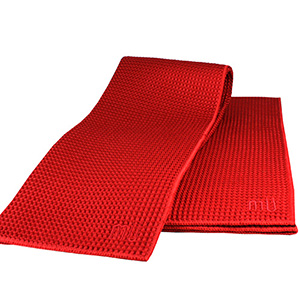Last weekend my now-former research assistant, who bought a house in the neighborhood shortly before Her Deanship announced the university would close our office and can us all, reported that the house was burgled while she and the kids were at church. The burglars missed her laptop, which was recharging in an out-of-the-way spot in the family room, but they did grab her husband’s laptop and cleaned out all her jewelry, most of which consisted of keepsakes from her mother.
Understandably, she’s feeling pretty disturbed and vulnerable, especially since the burglars entered with ease through the carport door. Apparently popping the lock was so easy, the cops said they couldn’t even find any evidence of forced entry. She’s taken to putting a piece of Scotch tape at the door’s threshhold so she can see whether anyone has entered before she goes into the house.
Even though our area is relatively safe compared to some parts of the city, no neighborhood is immune to burglaries and home invasions. I personally resent and resist living behind iron bars, glaring lights, and shrieking alarms. It’s the criminals who belong in jail, not us!
Over time, I’ve developed a number of strategies to minimize the risk of burglaries and the damage done if a perp gets into the house. Some of these are psycho-philosophical, some are mechanical.

On the philosophical level, I’ve adjusted my attitude about break-ins. Except for the dog, the stuff I have in my house is junk. Most of it is low in value—the only things that really matter are the computers, and even those are not the point: what matters is not the computer; it’s the data in the computer. The data can easily be backed up onto a flashdrive and carried around on one’s keyring, thereby protecting the only truly important inanimate object in the house.
So. My attitude is that I don’t much care if the burglar comes visiting, as long as he stays out of the house while I’m here. I don’t want a home invasion, several of which we have had in this neighborhood, because anyone who knowingly breaks into your house while you’re there doesn’t mean you any good. But otherwise…meh!

For my home office, I installed a solid-core door and a heavy-duty pick-resistant lock whose bolt slides through the framing into the stud next to the door frame. While it’s not 100 percent burglar-proof, it sure will slow the perp down. Outside the window, which faces the street, I planted the thorniest, fiercest roses I could find, and this spring a man-eating bougainvillea may join them. Most burglars would rather enter where they can’t be seen, and obviously they’d prefer an entrance that is not going to leave them bleeding.
From the guys who put the elegant lock on my office door, I learned that most locks are very easy to open. The lock they installed will break the perp’s drill bit if he tries to drill the lock. Trouble is, it ain’t cheap. On the other hand…what’s peace of mind worth?
Other than discouraging entry to my office in my absence, for me the trick is not to make unauthorized entry impossible but to force the perp to make enough noise to alert me if I’m here when he tries to get in. All I want is enough lead time to get out a different door and run down the street—or to barricade myself and the dog inside the office behind the pick-resistant lock so that I can call the cops or, if the phone’s disconnected, climb out the front window.
On the front entrance, I installed a low-end security door, purchased at Lowe’s. The problem is, the locks you buy at big box stores are just ordinary door locks; even the best are simple to defeat. Though the metal door itself is pretty strong, it’s only as burglar-resistant as the lock. To get a security door that will really deter burglars, you have to buy a specialty lock and have a locksmith install it. So, I think of the security door as something that will slow the burglar down a bit and cause him to make enough noise to alert the yapping dog while he’s trying to get in. Here, the point is to let me get out the back door while he’s trying to get in the front.
My house, like my RA’s, has several Arcadia doors, and all the the windows are also sliders. These, as we know, are extremely vulnerable. Some people install bars over the windows and double-wide security doors over the sliding doors. This strategy is counterproductive for two reasons:
• Barring intruders from getting in through a window means you also bar yourself from getting out during a fire. The idea that a set of bars will have locked release catches and in an emergency you’ll find the key, unlock them, and then climb out is highly problematic. In a fire, smoke can cause true black-out conditions. If the power is out, as it’s likely to be once a fire gets going good, you can find yourself trapped in a bedroom with no light, even if there’s little smoke to blind you. Children in particular are likely to panic in these conditions and not be able to find the key or remember how to work it. Personally, I’d rather go mano-à-mano with the burglar than die in a fire.
• Security doors are not at all difficult to break through. All it takes is a crowbar.
La Bethulia had those one of those double-wide security doors put over an Arcadia door in the back of her house. She went out to dinner for about an hour one evening and when she got back some guy had pried it open and had a nice visit. The locksmith told me he felt they’re a waste of money because they’re way too easy to break into, and that for the cost you’re better off installing an alarm system.
A sliding door or window can be secured pretty well in one of several ways:
• Put a piece of doweling in the track along the bottom. This makes it impossible to lift the door and slide it open. An alternative is to drive a small metal screw into the metal frame at the top of the door, tightening it just enough that the head of the screw clears the top of the slider. This also will block a person from lifting the slider far enough off its track to slip the lock and push it open.
• Install two sliding bolts, one that slides downward into a hole drilled in the concrete slab or window frame, and one that slides upward into the frame above the door or window. Be sure the bolt on top side of the door is long enough to slide well into the wood frame. If you place them intelligently, they’re hard or even impossible to see from outside, and so this will usually discourage the perp.
• Get screw-on locks made for sliding doors. They come in two varieties: one with a little lever that you just turn to tighten the device down, and one with a key lock. However, remember that everyone in the house, including children and the very elderly, needs to be able to get out in a fire. These things mustn’t be tightened down so much that a kid can’t get it open quickly and easily, or out of a child’s reach. Better to lose the jewelry and the computer than the kids.
On all my sliders, I use both screw-on locks and dowels in the tracks. To get through a door or window that’s been secured in this way, you have to make some noise. Chances are, you’ll have to break the glass. Many burglars prefer not to break windows, because the noise can draw a neighbor’s attention. In any event, if you’re home, the sound of a man struggling to defeat these devices or breaking glass to get at them will alert you so you can get out before he gets in.

To add to the noise level, you can get inexpensive battery-run alarms that you can attach unobtrusively to sliding doors and windows. I found a lifetime supply of the things at Costco; no doubt Lowe’s and the Depot have them, too. They glue on. When the little switch is in the “on” position, the alarm emits an ear-vibrating shriek when the door or window is opened. Not a true burglar alarm, of course, but it’s enough to wake you up if someone tries to get into the house.
Just knowing that you’ll be alerted is usually enough to give you some peace of mind. I have them on all my sliding doors and windows, and on the dog door cover. Because, when the weather’s nice, I like to sleep with the front door open and the security door locked, I even put one on the security door, so it will go off like a banshee if someone drills that lock.
Should the burglar come a-calling while I’m out of the house, I’ve left a few treats around for him. For example, I have some check pads for old bank accounts that were closed years ago. I put a few of these in easily accessible drawers. If he finds them, he’ll think he’s scored a whole pad of negotiable instruments. An ancient Toshiba laptop, so superannuated it’s useless today, sits out where it’s easy to find. And I’ve also left a few fistfuls of cheap costume jewelry in a couple of drawers.
The things my mother gave me, which aren’t worth much but which I’d like not to lose, are hidden in strange places—yes, you could find them, but it would take some time and effort, both of which are in short supply for burglars.
Truth to tell, many burglars are fairly benign. They don’t relish violence—that’s why they burgle rather than mug, rob banks, or deal dope. My feeling is that if some guy wants to make off with the priceless necklace I made with $20.00 worth of stuff from the craft store, bully for him as long as he stays out of the house when I’m home. A few alarms and extra locks will keep you safe from intruders while you’re in the house, and as for the rest of it…BFD!




